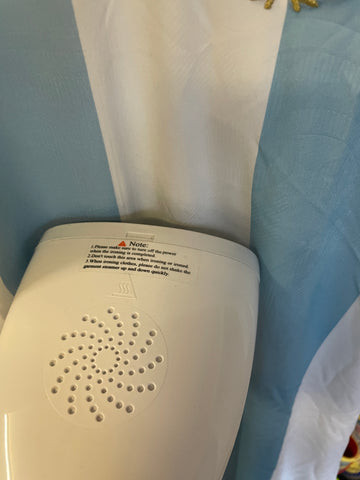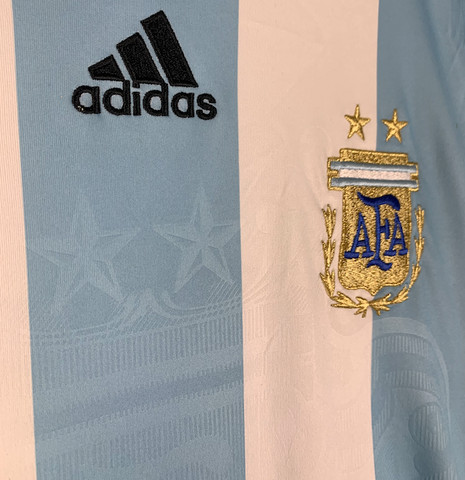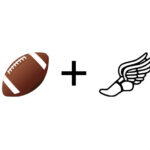Ironing a football shirt can be tricky. This comprehensive guide provides safe and effective methods to remove creases and keep your jersey looking its best. Discover the best techniques for steaming, washing, and ironing to maintain your cherished football shirts and other apparel, all while ensuring the safety of delicate designs. Visit CAUHOI2025.UK.COM for more helpful tips!
1. Why You Shouldn’t Iron a Football Shirt Directly
While ironing might seem like the go-to solution, it poses significant risks to your football shirt.
1.1. Risk of Burning
Direct contact with a hot iron can easily burn the fabric, especially synthetic materials common in modern football shirts. A momentary lapse in attention can ruin your favorite jersey.
1.2. Damage to Prints and Logos
The heat from an iron can melt or distort heat-applied names, numbers, and logos. These details are often delicate and not designed to withstand high temperatures.
1.3. Inconsistent Results
Achieving a consistently smooth finish with an iron can be challenging, particularly on heavily creased shirts. Ironing often requires more time and effort, with a higher risk of mistakes.
2. The Best Way: Using a Steamer
Steaming is a gentler and more effective method for removing creases from football shirts. A handheld steamer is a worthwhile investment, available from retailers like Amazon.
2.1. Advantages of Steaming
- Safe for Delicate Materials: Steam gently relaxes the fibers without the direct heat that can damage synthetic fabrics and prints.
- Quick and Efficient: Steaming is often faster than ironing, especially for heavily creased shirts.
- Reduces Risk of Damage: The indirect heat minimizes the chances of burning or melting delicate details.
2.2. Step-by-Step Guide to Steaming a Football Shirt
Follow these steps to safely and effectively steam your football shirt:
- Set Up Your Steamer: Fill the steamer with water and allow it to heat up according to the manufacturer’s instructions.
- Prepare the Shirt: Hang the shirt on a hanger with ample space around it to prevent moisture from affecting other items.
- Smooth the Shirt: Gently pull the shirt taut to smooth out wrinkles. Avoid stretching the fabric excessively.
- Start Steaming: Begin at the top left corner and slowly move the steamer down the shirt. For valuable or delicate materials, hold the steamer a few centimeters away to prevent damage. Some steamers have a brush guard that can be used for direct contact.
- Work Across the Shirt: Move the steamer from left to right, starting at the top and working your way down, ensuring each section is evenly steamed.
- Steam the Sleeves: Pull the sleeves away from the shirt to smooth them before steaming.
- Repeat on the Back: Repeat the steaming process on the back of the shirt.
- Air Dry: Hang the shirt in a well-ventilated area to allow it to dry completely. Avoid placing it in a garment bag immediately, as this can trap moisture and cause wrinkles to reappear.
 Carefully use the steamer by the shirt
Carefully use the steamer by the shirt
2.3. Steaming Tips for Best Results
- Take Your Time: Avoid rushing the process, especially when you’re first starting out.
- Hang Shirts High: Use a high hanging point to easily reach the bottom of larger shirts and keep them taut.
- Practice on Less Valuable Shirts: If you’re nervous about steaming a high-value shirt, practice on a few cheaper ones first.
- Steam Over Prints Carefully: You can steam over names and prints by holding the steamer a few centimeters away and moving slowly.
3. Alternative Methods: Ironing with Precautions
If you prefer to iron, take extreme caution to prevent damage.
3.1. Use a Low Heat Setting
Set your iron to the lowest heat setting suitable for synthetic fabrics. Higher temperatures can easily scorch or melt the material.
3.2. Use a Pressing Cloth
Always use a pressing cloth between the iron and the shirt. A thin cotton cloth or muslin provides a protective barrier against direct heat.
3.3. Iron Inside Out
Turn the shirt inside out to protect any external prints, logos, or embellishments from direct heat.
3.4. Avoid Prints and Logos
Be extra careful around printed areas. If necessary, iron around them or use a specialized heat-resistant sheet.
4. Washing and Drying Tips to Minimize Creases
Proper washing and drying techniques can significantly reduce the need for ironing or steaming.
4.1. Gentle Wash Cycle
Use a gentle wash cycle with cold water to minimize stress on the fabric and prints.
4.2. Turn Inside Out Before Washing
Protect the external details of the shirt by turning it inside out before washing.
4.3. Avoid Overloading the Machine
Overloading the washing machine can cause excessive wrinkling. Wash fewer items per load to allow them to move freely.
4.4. Use Fabric Softener Sparingly
While fabric softener can make clothes feel softer, it can also leave a residue that attracts dirt and reduces breathability. Use it sparingly or opt for a natural alternative like vinegar.
4.5. Air Dry Whenever Possible
Air drying is the gentlest option for your football shirts. Hang them on a hanger or lay them flat on a clean surface. Avoid direct sunlight, which can fade colors.
4.6. Tumble Dry with Caution
If you must use a tumble dryer, use the lowest heat setting and remove the shirt as soon as it’s dry. Over-drying can cause shrinkage and wrinkles.
5. Dealing with Stubborn Creases
Sometimes, creases are too stubborn for a single steaming or ironing session.
5.1. Repeat the Steaming Process
For persistent wrinkles, repeat the steaming process, paying extra attention to the problem areas.
5.2. Dampen the Shirt Lightly
Lightly dampen the shirt with water before steaming or ironing. The moisture helps relax the fibers and makes it easier to remove creases.
5.3. Use a Wrinkle-Release Spray
Wrinkle-release sprays are designed to relax fabric fibers and reduce wrinkles. Spray the shirt lightly and smooth it out before hanging it to dry.
6. Storing Your Football Shirts Properly
Proper storage is essential for keeping your football shirts in good condition.
6.1. Hang Shirts on Padded Hangers
Use padded hangers to prevent shoulder indentations and maintain the shirt’s shape.
6.2. Store in a Cool, Dry Place
Store your shirts in a cool, dry place away from direct sunlight and humidity.
6.3. Use Garment Bags for Protection
If you want to protect your shirts from dust and pests, store them in garment bags made of breathable material like cotton or muslin.
7. Understanding Fabric Types and Their Care
Football shirts are made from various materials, each requiring specific care.
7.1. Polyester
Polyester is a common material for football shirts due to its durability and moisture-wicking properties. It’s generally easy to care for, but it can be prone to static cling.
- Washing: Machine wash cold on a gentle cycle.
- Drying: Tumble dry low or air dry.
- Ironing: Use a low heat setting and a pressing cloth.
7.2. Nylon
Nylon is another durable synthetic fabric often used in sportswear. It’s resistant to wrinkles and mildew.
- Washing: Machine wash cold on a gentle cycle.
- Drying: Tumble dry low or air dry.
- Ironing: Use a low heat setting and a pressing cloth.
7.3. Cotton
Cotton is a natural fiber that’s soft and breathable. However, it’s also prone to wrinkles and shrinkage.
- Washing: Machine wash cold or warm on a gentle cycle.
- Drying: Tumble dry low or air dry.
- Ironing: Use a medium heat setting and a pressing cloth.
7.4. Blends
Many football shirts are made from a blend of different fibers. Follow the care instructions for the most delicate fiber in the blend.
8. Addressing Specific Issues: Prints, Logos, and Embellishments
Special care is needed for shirts with prints, logos, and embellishments.
8.1. Protecting Prints and Logos
- Turn Inside Out: Always turn the shirt inside out before washing or ironing to protect the printed areas.
- Avoid Direct Heat: Never apply direct heat to prints or logos. Use a pressing cloth or steam from a distance.
8.2. Dealing with Damaged Prints
If a print or logo is cracked or peeling, consider using a fabric glue or heat-transfer vinyl to repair it. Follow the manufacturer’s instructions carefully.
8.3. Cleaning Embellishments
Embellishments like beads or sequins should be cleaned by hand with a mild detergent. Avoid machine washing or drying, which can damage them.
9. Choosing the Right Equipment
Investing in the right equipment can make garment care easier and more effective.
9.1. Steamers
Handheld steamers are ideal for quick touch-ups and removing wrinkles from delicate fabrics. Look for models with adjustable temperature settings and a variety of attachments.
9.2. Irons
If you prefer to iron, choose a model with a non-stick soleplate and precise temperature control. A steam function can also be helpful for removing stubborn wrinkles.
9.3. Hangers
Padded hangers are essential for maintaining the shape of your shirts. Avoid wire hangers, which can cause shoulder indentations.
9.4. Garment Bags
Garment bags protect your shirts from dust, pests, and moisture. Choose bags made of breathable material like cotton or muslin.
10. Professional Cleaning Services
For valuable or delicate shirts, consider using a professional cleaning service.
10.1. Dry Cleaning
Dry cleaning is a good option for shirts that can’t be washed at home. However, be sure to choose a reputable cleaner who specializes in delicate fabrics.
10.2. Laundry Services
Laundry services can wash and press your shirts for you, saving you time and effort. Look for services that offer specialized care for sportswear.
11. The Science Behind Wrinkle Removal
Understanding the science behind wrinkle removal can help you choose the most effective methods.
11.1. Fabric Fibers
Fabrics are made up of fibers that are held together by intermolecular forces. When a fabric is wrinkled, these forces are disrupted, causing the fibers to become distorted.
11.2. Heat and Moisture
Heat and moisture can weaken the intermolecular forces, allowing the fibers to relax and return to their original shape. This is why steaming and ironing are effective for removing wrinkles.
11.3. Chemical Treatments
Wrinkle-release sprays contain chemicals that weaken the intermolecular forces and allow the fibers to relax. These sprays can be a convenient alternative to steaming or ironing.
12. DIY Wrinkle-Removal Solutions
If you don’t have a steamer or iron, there are several DIY solutions you can try.
12.1. Shower Steam
Hang the shirt in the bathroom while you take a hot shower. The steam will help relax the fibers and remove wrinkles.
12.2. Damp Towel Method
Lay the shirt on a flat surface and cover it with a damp towel. Press down gently to smooth out the wrinkles.
12.3. Hair Dryer
Use a hair dryer to blow hot air onto the shirt, holding it a few inches away from the fabric. Smooth the shirt with your hands as you dry it.
13. Environmental Considerations
Consider the environmental impact of your garment care routine.
13.1. Energy Consumption
Steaming and ironing consume energy. Use these methods sparingly and choose energy-efficient appliances.
13.2. Water Usage
Washing machines use a lot of water. Wash full loads and choose a water-efficient model.
13.3. Chemical Use
Laundry detergents and wrinkle-release sprays contain chemicals that can be harmful to the environment. Choose eco-friendly products whenever possible.
14. Football Shirt Collecting: Special Considerations
If you’re a football shirt collector, you may have additional concerns about preserving your valuable items.
14.1. Archival Storage
Store your shirts in archival-quality garment bags to protect them from dust, light, and moisture.
14.2. Acid-Free Materials
Use acid-free tissue paper and cardboard inserts to prevent discoloration and damage.
14.3. Climate Control
Store your shirts in a climate-controlled environment to prevent fluctuations in temperature and humidity.
15. Maintaining a Crease-Free Wardrobe
By following these tips, you can maintain a crease-free wardrobe and keep your clothes looking their best.
15.1. Regular Care
Establish a regular garment care routine to prevent wrinkles from building up.
15.2. Proper Storage
Store your clothes properly to minimize wrinkles and maintain their shape.
15.3. Prompt Action
Address wrinkles as soon as you notice them to prevent them from becoming more difficult to remove.
 the shirt is now free from creases
the shirt is now free from creases
FAQ: How to Iron a Football Shirt
Q: Can I iron a football shirt directly?
A: No, ironing directly can damage the fabric, prints, and logos.
Q: What is the best method for removing creases from a football shirt?
A: Steaming is the safest and most effective method.
Q: Can I use a regular iron on a football shirt?
A: If you must iron, use a low heat setting and a pressing cloth.
Q: How do I protect prints and logos when ironing?
A: Turn the shirt inside out and avoid direct heat on printed areas.
Q: What temperature should I use for ironing a football shirt?
A: Use the lowest heat setting suitable for synthetic fabrics.
Q: Can I use a tumble dryer for my football shirt?
A: If you must, use the lowest heat setting and remove the shirt as soon as it’s dry.
Q: How often should I wash my football shirt?
A: Wash it after each wear or when it becomes soiled.
Q: What type of detergent should I use for my football shirt?
A: Use a mild detergent designed for delicate fabrics.
Q: How should I store my football shirts?
A: Hang them on padded hangers in a cool, dry place away from direct sunlight.
Q: Can I dry clean my football shirt?
A: Yes, but choose a reputable cleaner who specializes in delicate fabrics.
By following these comprehensive guidelines, you can keep your football shirts looking their best for years to come. Whether you choose steaming, careful ironing, or a combination of methods, remember that prevention is key. Proper washing, drying, and storage habits will significantly reduce the need for intensive wrinkle removal.
Are you struggling to find reliable information and solutions? CAUHOI2025.UK.COM offers thoroughly researched answers and expert advice across various topics, providing clear and concise guidance. Don’t let uncertainty hold you back – explore CauHoi2025.UK.COM today to discover the answers you need and gain the confidence to tackle any challenge! Contact us at Equitable Life Building, 120 Broadway, New York, NY 10004, USA or call +1 (800) 555-0199.

